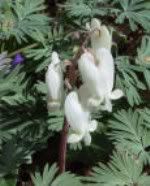

Bleeding Heart (Dicentra spectabilis, D Canadensis)
Folk Names: Bicuculla Canadensis, Chinamen's Breeches, Corydalis, Corydalis Canadensis, Enfant-Jesus en berceau (French- Infant Jesus in Cradle), Lady in a Bath, Lady's Ear-Drops, Lady's Locket, Lyre Flower, fleur de Marie (French- Mary’s Flower), coeur de Marie (French- Mary’s Heart), Our Lady in a Boat, Saint-Esprit (French- Holy Spirit), Shone Corydalis, Staggerweed, Turkey Corn, Turkey Pea
Description: Dicentra spectabilis is the most common and commercial version of the plant known commonly as Bleeding Heart. It is a perennial, and a member of the Papaveraceae, or poppy family. Some 150 varieties of this flower are found in North America, western Asia, and the Himalayas.
Each Bleeding Heart forms a clump about three feet high. The finely cut, fern-like leaves are ternately compound. In early spring to mid-summer, arching racemes produced one to ten flowers on slender stalks. The outer petals are rose pink, while the inner petals are white to creamy in color. The white inner petals protrude from the rose-pink outer petals giving the appearance of a bleeding heart. It prefers a full sun position in cool areas. In warm areas this species is better suited to a semi-shaded position. It needs to remain moist at all times. The rind of the root is black and white inside. When dried, it turns a brownish yellow, and under a microscope, is very porous. It has a faint odor, and if tasted, it is slightly bitter followed by a sharper taste which influences the bowels and increases saliva.

Dicentra Canadensis is a wild version found in rich woodlands. It is indigenous to America, found west and south of New York to North Carolina. Turkey Corn normally grows from six to ten inches high. There may be anywhere from six to nineteen flowers on each stalk, and the flowers are greenish-white, purple tinged flowers. The root-tuber is small and round, and a tawny yellow color. The root of Turkey Corn is slightly bitter in taste and almost odorless.
Effects: gentle
Planet: Venus
Element: Water
Associated Deities:
Traditions:
Once upon a time, or so the story goes, there lived a very beautiful and very vain princess. Young men from all over the world came to woo her, but she would have nothing to do with any of them.
A young prince from a neighboring country fell deeply in love with her. Like the others, she ignored him despite his attempts to win her heart. At the market one day, he found a pair of pretty pink rabbits, sending them to her in the hope of winning her over. (Break off the two outside petals of the flower, resembling a pair of pink rabbits.) The princess was not impressed. The prince then sent her a pair of beautiful Oriental slippers. (Remove the two long petals from the front and back of the flower. They look like a pair of slippers.) Still she would have nothing to do with him. The young prince was so heart broken by her indifference that he took his dagger and drove it into his heart. (The remains of the flower make the outline of a heart with a line down the center. Break out the stamen, which looks like a dagger, and put it through the center of the heart.)
As soon as the prince was dead, of course the princess realized that she had really loved him. She vowed that as long as she lived, her heart would bleed for her prince.
Magic:
Bleeding heart, is used mainly in love spells and divination. Crush the flower. If juice is red, your love loves you, but white means you are not loved. It may also be grown for love, but not indoors. Unless a coin (copper penny) is placed in the soil, the plant tends to emit negative vibrations as a houseplant. I have read that this is possibly because love needs room to grow, and the plant feels confined indoors.
Known Combinations:
none noted
Medical Indications: (Warning: Contact with the plant can cause skin irritation in some people. D spectabilis is not used medicinally.) Parts Used : dried tubers (should be harvested while plant is in flower)
The root of Turkey Corn is used as a diuretic and tonic. It is more often used in combination with other herbal remedies than alone.
Nutrition:
none
Mercantile Uses:
Bleeding Heart is a popular garden plant suitable for borders and shady nooks.